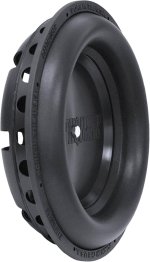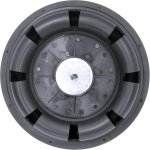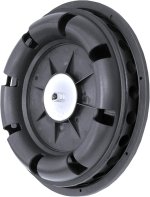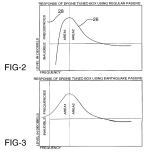I was reading about SLAPS Passive Radiators. Please see attached SLAPS_manual_ENG.pdf. It just has two back to back attached surrounds sharing same PR disk mass.
Attached are front, side and rear images of SLAPS PR, the slots on one surround are just to avoid air compression during operation which will otherwise damp the movement, for our discussion, the slots can be ignored and we can assume that there are two back to back surrounds without these slots.
One effect I immediately see is that this SLAPS will increase effective stiffness of the PR as each surround is bringing its own stiffness. I assume that we can punch in the numbers in a PR simulation program like Unibox and generate the frequency response of the system.
However, I was surprised to read SLAPS_manual_ENG.pdf and found some things deviating from usual theory of PR working and I have listed down only those points below. Can we have a discussion on each point to either accept it as mentioned in SLAPS_manual_ENG.pdf or dismiss it as gimmick? I have also mentioned my understanding for each of the point below in italics.
1) Claim: The revolutionary efficiency and performance are the result of the pneumatic coupling between SLAPS and the active driver.
Wait, 'pneumatic coupling'? I thought this supposed pneumatic coupling was also valid with a normal PR, how does that suddenly improve with SLAPS?
2) Claim: The unique design allows the active driver compression-free movement resulting in deep, dynamic and hard-hitting bass response.
In case of normal PR, the PR size is one greater than active driver, for eg for 12" active driver, a 15" PR is recommended so that we dont get xmax related compression. Whats so different with SLAPS?
3) Claim: Conventional computer modeling software will not work correctly with SLAPS and will in most cases greatly overestimate the internal volume of the optimal cabinet.
Why does double surround PR break simulation?
4) Claim: SLAPS increases a subwoofer efficiency and capability for ultra low frequency reproduction (very deep Sub-bass) without the drawbacks of traditional designs.
So, I read the patent and attached the PR excursion vs frequency plot from the patent, as you can see they show more extension for SLAPS and a steep fall response for normal PR, why this difference in bass extension between both?
5) Claim: It gives you much better performance due to the increased surface area and the fact that the particles of air
inside the enclosure and outside the cabinet moves with the same speed and in a near phase relationship. Phase means that the active device and SLAP work almost concurrently and simultaneously creates respectively pressure and counter-pressure at the same time.
Now, what is being said? I am lost in the phase jargon. And both active and PR dont move in unison, there is air spring the sound wave has to travel that air-spring, of course due to the wavelengths being so large they may appear concurrent due to very small delay, but this is valid for normal PR also. What is so different with SLAPS?
6) Claim: A traditional bass reflex port design, the system is limited in performance due to the air in the reflex port not being in phase or at the same speed of movement as the air in front of the active driver.
As far as I understand the PR does exactly what the cylindrical air mass of air does in a bass reflex port. What limited performance is being described, is it port velocity limit of port?
7) Claim: Active woofer unit should preferably have a resonance frequency (FS) of 30Hz or less and not more than 35 HZ.
In the entire document, TS parameters are never considered or even mentioned and now this limit imposed on Fs, why cant I take Fs of 40Hz and tune PR to 25Hz? Haven't people done that already?
8) Claim: Typically 16 mm MDF or thicker. Particleboard or plywood are also excellent materials.
For long stroke active driver and long stroke SLAPS PR, isn't 16mm too thin, should it instead be saying to use more thickness and more bracing than used typically?
9) Claim: It is important that you do not exceed the maximum specified enclosure volume. The air inside the cabinet acts like a spring and the larger the enclosure the lower the linear output. This also introduces distortion.
10 "inch 20 - 45 liters internal volume sealed cabinet
12" inch 30-60 liters internal volume sealed cabinet
15 "inch 35-100 liters internal volume sealed cabinet
18" inch 50-140 liters internal volume sealed cabinet
As far as I understand the opposite is true, and this is what I read, I dont remember where. Lets assume the volume of air displaced at Xmax of active driver is Vxmax in each direction, then as the cone goes in at Xmax the active driver reduces the volume of the enclosure by Vxmax and the stiffness of the enclosued volume increases, same way, as the cone goes out at Xmax the active driver increases the volume of the enclosure by Vxmax and the stiffness of the enclosued volume decreases. This increase and decrease if substantial, causes distortion. If the enclosure volume is large then the Vmax and the corresponding change in stiffness is negligible and distortion is negligible. Now, if if we reduce the enclosure volume then this Vmax becomes a sufficient portion of enclosure volume causing large changes in stiffness at both the ends at Xmax, thus distortion increases. The Vmax of the driver should not be more than 5% of the enclosure essentially putting a lower limit on tghe enclosed volume. Thus, a large active driver needs larger enclosure and higher Xmax also needs a larger enclosure. Of course, the actual frequency response still has to be simulated. Isn't it the same reason that when Sunfire put their large excursion drivers into very small enclosures they had to improve distortion using servo based electronics/amplifier? How does a small volume benefit SLAPS?
10)Claim: By placing SLAPS right next to the active woofer so you run the risk that at the acoustic resonance frequency there may be a negative interference which and the can lower the overall sound pressure level of the deepest bass tones. The lower the resonance is set, the less likely it is that there will be an issue. Best results are obtained by placing it on the back or side of the cabinet.
Firstly at box resonance the active driver moves the least, it hardly produces sound, the entire output at this frequency is from SLAPS so where is the claimed cancellation coming from. And if we move the SLAPS to rear even then both the drivers output is within 1/4 wavelength, so if cancellation has to somehow occur, it will occur the same way with a rear mounted SLAPS, no?
Thanks in advance,
Warm Regards,
WonderfulAudio
Attached are front, side and rear images of SLAPS PR, the slots on one surround are just to avoid air compression during operation which will otherwise damp the movement, for our discussion, the slots can be ignored and we can assume that there are two back to back surrounds without these slots.
One effect I immediately see is that this SLAPS will increase effective stiffness of the PR as each surround is bringing its own stiffness. I assume that we can punch in the numbers in a PR simulation program like Unibox and generate the frequency response of the system.
However, I was surprised to read SLAPS_manual_ENG.pdf and found some things deviating from usual theory of PR working and I have listed down only those points below. Can we have a discussion on each point to either accept it as mentioned in SLAPS_manual_ENG.pdf or dismiss it as gimmick? I have also mentioned my understanding for each of the point below in italics.
1) Claim: The revolutionary efficiency and performance are the result of the pneumatic coupling between SLAPS and the active driver.
Wait, 'pneumatic coupling'? I thought this supposed pneumatic coupling was also valid with a normal PR, how does that suddenly improve with SLAPS?
2) Claim: The unique design allows the active driver compression-free movement resulting in deep, dynamic and hard-hitting bass response.
In case of normal PR, the PR size is one greater than active driver, for eg for 12" active driver, a 15" PR is recommended so that we dont get xmax related compression. Whats so different with SLAPS?
3) Claim: Conventional computer modeling software will not work correctly with SLAPS and will in most cases greatly overestimate the internal volume of the optimal cabinet.
Why does double surround PR break simulation?
4) Claim: SLAPS increases a subwoofer efficiency and capability for ultra low frequency reproduction (very deep Sub-bass) without the drawbacks of traditional designs.
So, I read the patent and attached the PR excursion vs frequency plot from the patent, as you can see they show more extension for SLAPS and a steep fall response for normal PR, why this difference in bass extension between both?
5) Claim: It gives you much better performance due to the increased surface area and the fact that the particles of air
inside the enclosure and outside the cabinet moves with the same speed and in a near phase relationship. Phase means that the active device and SLAP work almost concurrently and simultaneously creates respectively pressure and counter-pressure at the same time.
Now, what is being said? I am lost in the phase jargon. And both active and PR dont move in unison, there is air spring the sound wave has to travel that air-spring, of course due to the wavelengths being so large they may appear concurrent due to very small delay, but this is valid for normal PR also. What is so different with SLAPS?
6) Claim: A traditional bass reflex port design, the system is limited in performance due to the air in the reflex port not being in phase or at the same speed of movement as the air in front of the active driver.
As far as I understand the PR does exactly what the cylindrical air mass of air does in a bass reflex port. What limited performance is being described, is it port velocity limit of port?
7) Claim: Active woofer unit should preferably have a resonance frequency (FS) of 30Hz or less and not more than 35 HZ.
In the entire document, TS parameters are never considered or even mentioned and now this limit imposed on Fs, why cant I take Fs of 40Hz and tune PR to 25Hz? Haven't people done that already?
8) Claim: Typically 16 mm MDF or thicker. Particleboard or plywood are also excellent materials.
For long stroke active driver and long stroke SLAPS PR, isn't 16mm too thin, should it instead be saying to use more thickness and more bracing than used typically?
9) Claim: It is important that you do not exceed the maximum specified enclosure volume. The air inside the cabinet acts like a spring and the larger the enclosure the lower the linear output. This also introduces distortion.
10 "inch 20 - 45 liters internal volume sealed cabinet
12" inch 30-60 liters internal volume sealed cabinet
15 "inch 35-100 liters internal volume sealed cabinet
18" inch 50-140 liters internal volume sealed cabinet
As far as I understand the opposite is true, and this is what I read, I dont remember where. Lets assume the volume of air displaced at Xmax of active driver is Vxmax in each direction, then as the cone goes in at Xmax the active driver reduces the volume of the enclosure by Vxmax and the stiffness of the enclosued volume increases, same way, as the cone goes out at Xmax the active driver increases the volume of the enclosure by Vxmax and the stiffness of the enclosued volume decreases. This increase and decrease if substantial, causes distortion. If the enclosure volume is large then the Vmax and the corresponding change in stiffness is negligible and distortion is negligible. Now, if if we reduce the enclosure volume then this Vmax becomes a sufficient portion of enclosure volume causing large changes in stiffness at both the ends at Xmax, thus distortion increases. The Vmax of the driver should not be more than 5% of the enclosure essentially putting a lower limit on tghe enclosed volume. Thus, a large active driver needs larger enclosure and higher Xmax also needs a larger enclosure. Of course, the actual frequency response still has to be simulated. Isn't it the same reason that when Sunfire put their large excursion drivers into very small enclosures they had to improve distortion using servo based electronics/amplifier? How does a small volume benefit SLAPS?
10)Claim: By placing SLAPS right next to the active woofer so you run the risk that at the acoustic resonance frequency there may be a negative interference which and the can lower the overall sound pressure level of the deepest bass tones. The lower the resonance is set, the less likely it is that there will be an issue. Best results are obtained by placing it on the back or side of the cabinet.
Firstly at box resonance the active driver moves the least, it hardly produces sound, the entire output at this frequency is from SLAPS so where is the claimed cancellation coming from. And if we move the SLAPS to rear even then both the drivers output is within 1/4 wavelength, so if cancellation has to somehow occur, it will occur the same way with a rear mounted SLAPS, no?
Thanks in advance,
Warm Regards,
WonderfulAudio
Attachments
The only advantage I see is that it does not have a spider, which means it has a lower free air resonance frequency. You get a dip here so better have it as low as possible.
1) "Pneumatic coupling" is pure marketing term. It is the same as coupling between woofer and vent/PR.
2) No difference here between regular PR and SLAPS, except maybe bigger Xmax of SLAPS.
3) No difference between regular PR and SLAPS regarding simulation.
4) Didn't read the patent, but attached graphs are not measured response - i.e. pure fiction.
5) No difference here between regular PR and SLAPS.
6) Limit of ports is air noise at max velocity limit. PR (and SLAPS) has no such limit.
7) SLAPS parameters maybe are optimized for low Fs woofers.
8) It says "16 mm or thicker", so it is OK. Of course bracing is recommended practice.
9) Those recommended volumes are just a rule of thumb -do not relay on them, do the proper simulation. Otherwise, recommendation for avoiding excessive volume is OK, but the explanation is silly.
10) Actually, this is a good advice.
As @TBTL pointed out, SLAPS has symmetrical construction (=good). Also, SLAPS depth is smaller than conventional PR (=good).
2) No difference here between regular PR and SLAPS, except maybe bigger Xmax of SLAPS.
3) No difference between regular PR and SLAPS regarding simulation.
4) Didn't read the patent, but attached graphs are not measured response - i.e. pure fiction.
5) No difference here between regular PR and SLAPS.
6) Limit of ports is air noise at max velocity limit. PR (and SLAPS) has no such limit.
7) SLAPS parameters maybe are optimized for low Fs woofers.
8) It says "16 mm or thicker", so it is OK. Of course bracing is recommended practice.
9) Those recommended volumes are just a rule of thumb -do not relay on them, do the proper simulation. Otherwise, recommendation for avoiding excessive volume is OK, but the explanation is silly.
10) Actually, this is a good advice.
As @TBTL pointed out, SLAPS has symmetrical construction (=good). Also, SLAPS depth is smaller than conventional PR (=good).
As Sonce pointed out, most of your questions are in regard to statements made in the manual which have no technical explanation to back them up in the patent or real life, poorly translated "marketing speak".However, I was surprised to read SLAPS_manual_ENG.pdf and found some things deviating from usual theory of PR working and I have listed down only those points below. Can we have a discussion on each point to either accept it as mentioned in SLAPS_manual_ENG.pdf or dismiss it as gimmick?
The badly written, out of date manual appears to originate from the European distributor, as far as I can see does not appear on the main USA Earthquake Sound website, and conflicts with information in their current manuals.
The 10", 12" and 15" SLAPS 4" (100mm) peak to peak excursion (incorrectly specified as "Xmax) is much greater than most PRs, while it's overall depth is much less, and the symmetrical suspension better behaved at high excursions while supporting the mass needed to tune large PRs to low frequencies.
Since four times the displacement is required for each halving of frequency to maintain the same level, the usual rule of thumb for passive radiators is their displacement should be at least twice that of the active driver to maintain a similar SPL around Fb as ~1/3 octave above that where the active driver's excursion is at maximum.
The SLAPS excursion capability is more than double that of most subwoofer's Xmax, so a single of the same diameter as the active driver may be enough to satisfy the displacement required.
I didn't know that - 100mm is phenomenally good!The 10", 12" and 15" SLAPS 4" (100mm) peak to peak excursion (incorrectly specified as "Xmax) is much greater than most PRs
The smallest SLAPS 8" has 3.5" (~88mm) peak to peak excursion, good for around 100dB maximum at 20Hz with no room gain.I didn't know that - 100mm is phenomenally good!
The 10" ~105dB, the 12" ~108, 15" ~112dB at 20Hz, more than enough to make well braced drywall flap.
The current SLAPS-15v2 is designed for an Fb ~20Hz in a ~2 cubic foot/56L box.
Using passive radiators capable of that much excursion, you really can make small boxes capable of surprising amounts of low frequency.
The specs of the SLAPS 8 are a bit ... unusual.
For example, its specs include an Fs of 48 Hz (seems a bit high) and a Q of 0.32 (which seems incredibly low there are many 8" DRIVERS that don't have a Q that low ..!).
Compare that for example with the Dayton Audio RSS210, with its Fs of 19.5 Hz and Q of 10.7 ...
For example, its specs include an Fs of 48 Hz (seems a bit high) and a Q of 0.32 (which seems incredibly low there are many 8" DRIVERS that don't have a Q that low ..!).
Compare that for example with the Dayton Audio RSS210, with its Fs of 19.5 Hz and Q of 10.7 ...
Can anyone please explain 10) ? I dont get it, at tuning frequency the active driver is hardly moving and PR is moving a lot. How do they cancel coz they dont have same SPL a necessity for cancellation to occur?
There is no cancelation at the tuning frequency, 10) is talking about something else - supposedly harmful interference when PR (or bass-reflex tube) is very close to the woofer.
The Fs of 48Hz is with no weight added, an Mms of only 75.6 grams, it has an additional mass of 160 grams pre-installed.The specs of the SLAPS 8 are a bit ... unusual.
For example, its specs include an Fs of 48 Hz (seems a bit high) and a Q of 0.32 (which seems incredibly low there are many 8" DRIVERS that don't have a Q that low ..!).
Compare that for example with the Dayton Audio RSS210, with its Fs of 19.5 Hz and Q of 10.7 ...
- Home
- Loudspeakers
- Subwoofers
- Why SLAPS behaves so much differently from traditional Passive Radiators?



